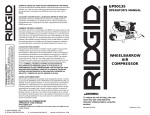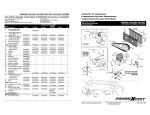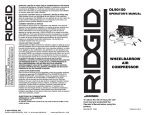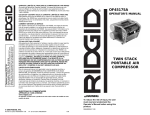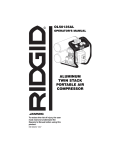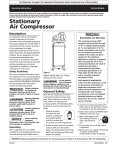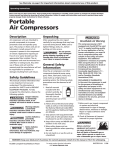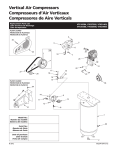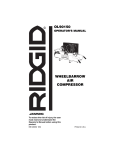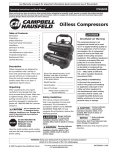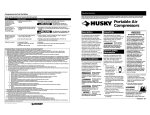Download Ricoh Wide Format Color Scanner Scanner User Manual
Transcript
GP90135 OPERATOR’S MANUAL WHEELBARROW AIR COMPRESSOR ! WARNING Read and follow all Safety Rules before first use of this product. IN610400AV Printed in U.S.A. Table of Contents Section Safety Instructions Page Section Table of Contents . . . . . . . . . . . . . . . .2 Page Maintenance . . . . . . . . . . . . . . . . . . .13 Maintenance Schedule . . . . . . . . . .13 Tank . . . . . . . . . . . . . . . . . . . . . . . . .14 Filter Removal, Inspection, and Replacement . . . . . . . . . . . . . . . . . .14 Drive Belt . . . . . . . . . . . . . . . . . . . . .15 Storage . . . . . . . . . . . . . . . . . . . . . .15 Safety Instructions . . . . . . . . . . . . . . .3 Safety Signal Words . . . . . . . . . . . . .3 Before Using the Air Compressor . . . . . . . . . . . . . . . . . . . .3 Spraying Precautions . . . . . . . . . . . .5 Breathable Air Warning . . . . . . . . . . .5 Warning Labels . . . . . . . . . . . . . . . . .6 Troubleshooting . . . . . . . . . . . . . . . .16 Glossary of Terms . . . . . . . . . . . . . . .7 Notes . . . . . . . . . . . . . . . . . . . . . . . . .19 Unpacking and Checking Content . . . . . . . . . . . . . . . . . . . . . . . .8 Repair Parts . . . . . . . . . . . . . . . . . . .20 Getting to Know Your Air Compressor . . . . . . . . . . . . . . . . . . . .8 Warranty . . . . . . . . . . . . . . . . . . . . . .24 Warning indicates ! WARNING a potentially hazardous situation which, if not avoided, COULD result in death or serious injury. This manual contains information that is very important to know and understand. This information is provided for SAFETY and to PREVENT EQUIPMENT PROBLEMS. To help recognize this information, observe the following symbols. Caution indicates a potentially hazardous situation which, if not avoided, MAY result in minor or moderate injury. ! Safety Signal Words Danger indicates an imminently hazardous situation which, if not avoided, WILL result in death or serious injury. ! DANGER CAUTION Notice indicates important information, that if not followed, may cause damage to equipment. !NOTICE Notes . . . . . . . . . . . . . . . . . . . . . . . . .22 Before Using the Air Compressor Operating Your Air Compressor . . .10 Moisture in Compressed Air . . . . . .10 Lubricaton . . . . . . . . . . . . . . . . . . . .11 Start-up . . . . . . . . . . . . . . . . . . . . . .11 To Start Gasoline Engine . . . . . . . .12 deterioration, weakness or leakage. Repair or replace defective items before using. Since the air compressor and other components (pump, spray guns, filters, lubricators, hoses, etc.) used make up a high pressure pumping system, the following safety precautions must be observed at all times: 1. Read all manuals included with this product carefully. Be thoroughly familiar with the controls and the proper use of the equipment. 8. Check all fasteners at frequent intervals for proper tightness. ! WARNING Never operate compressor without a beltguard. Compressors can start automatically without warning. Personal injury or property damage could occurfrom contact with moving parts. MANUAL 2. Follow all local safety codes as well as the United States Occupational Safety and Health Act (OSHA). 3. Only persons well acquainted with these rules of safe operation should be allowed to use the compressor. 9. Do not wear loose clothing or jewelry that will get caught in the moving parts of the unit. 4. Keep visitors away and NEVER allow children in the work area. 5. Wear safety glasses and use hearing protection when operating the pump or unit. ! 6. Do not stand on or use the pump or unit as a handhold. 7. Before each use, inspect compressed air system, fuel system and electrical components for signs of damage, 2 CAUTION Compressor parts may be hot even if the unit is stopped. 3 Safety Instructions (continued) 10. Keep fingers away from a running compressor; fast moving and hot parts will cause injury and/or burns. repair in or near a flammable gas or vapor. Never store flammable liquids or gases in the vicinity of the compressor. 11. If the equipment should start to vibrate abnormally, STOP the engine/motor and check immediately for the cause. Vibration is generally a warning of trouble. ! WARNING Carbon monoxide can cause severe nausea, fainting or death. Do not operate unit inside a closed building or a poorly ventilated area. ! WARNING NEVER refuel a running or hot engine. Explosive fuel can cause fires and severe burns. Avoid overfilling fuel tank. 13. To reduce fire hazard, keep engine/motor exterior free of oil, solvent, or excessive grease. 12. Check fuel level before starting the engine. Do not fill the gas tank indoors. Wipe off any spilled gas before starting the engine. ! ! WARNING Never remove or attempt to adjust safety valve. Keep safety valve free from paint and other accumulations. DANGER Gasoline vapor is highly flammable. Refill outdoors or only in well ventilated areas. Do not store, spill or use gasoline near an open flame or heat devices such as a stove, furnace, or water heater, which utilize a pilot light, or any device that can create a spark. If gasoline is accidentally spilled, move unit away from the spill area and avoid creating any source of ignition until gasoline vapors have dissipated. 17. STOP the engine whenever leaving the work area, before cleaning, making repairs or inspections. When cleaning, ! DANGER Never attempt to repair or modify a tank! Welding, drilling or any other modification will weaken the tank resulting in damage from rupture or explosion. Always replace worn or damaged tanks. ! WARNING Motors, electrical equipment and controls can cause electrical arcs that will ignite a flammable gas or vapor. Never operate or 15. Tanks rust from moisture build-up, which weakens the tank. Make sure to drain tank daily and inspect periodically for unsafe conditions such as rust formation and corrosion. 4 18. Allow engine to cool before storing. Spraying Precautions ed area to prevent health and fire hazards. ! WARNING Do not spray flammable materials in vicinity of open flame or near ignition sources including the compressor unit. 21. Do not direct paint or other sprayed material at the compressor. Locate compressor as far away from the spraying area as possible to minimize overspray accumulation on the compressor. 19. Do not smoke when spraying paint, insecticides, or other flammable substances. 22. When spraying or cleaning with solvents or toxic chemicals, follow the instructions provided by the chemical manufacturer. 20. Use a face mask/respirator when spraying and spray in a well ventilat- ! 14. Do not tamper with governor setting on engine. Overspeeding the unit severely shortens engine life and may also be very hazardous. repairing or inspecting, make certain all moving parts have stopped. Disconnect the spark plug wire and keep the wire away from the plug to prevent accidental starting. 16. Fast moving air will stir up dust and debris which may be harmful. Release air slowly when draining moisture or depressurizing the compressor system. DANGER Breathable Air Warning This compressor/pump is not equipped and should not be used “as is” to supply breathing quality air. For any application of air for human consumption, the air compressor/pump will need to be fitted with suitable in-line safety and alarm equipment. This additional equipment is necessary to properly filter and purify the air to meet minimal specifications for Grade D breathing as described in Compressed Gas Association Commodity Specification G 7.1 - 1966, OSHA 29 CFR 1910. 134, and/or Canadian Standards Associations (CSA). DISCLAIMER OF WARRANTIES In the event the compressor is used for the purpose of breathing air application and proper in-line safety and alarm equipment is not simultaneously used, existing warranties shall be voided, and Campbell Hausfeld disclaims any liability whatsoever for any loss, personal injury or damage. 5 Safety Instructions (continued) Glossary of Terms Warning Labels ASME Safety Valve A safety valve that automatically releases the air if the air receiver (tank) pressure exceeds the preset maximum. Find and read all warning labels found on the air compressor shown below Amps or Amperage A measure of the electrical force minus the resistance on an electrical line. Ridgid air compressors require 15 amps for operation. Be sure the compressor will operate on an electrical line with the proper amps. If other appliances operate on the same line, they will reduce the available amps. If the amperage is not adequate, the result will be blown fuses or tripped circuits. PSI (Pounds per Square Inch) Measurement of the pressure exerted by the force of the air. The actual psi output is measured by a pressure gauge on the compressor SCFM (Standard Cubic Feet per Minute) Sometimes called CFM (Cubic Feet per Minute). Measurement of air volume delivered by the compressor. Regulator A control that adjusts the line pressure to the proper amount needed to operate spray guns and air tools. Air Delivery A combination of psi and SCFM. The air delivery required by a tool is stated as (number) SCFM at (number) psi. The combination of these figures determines what size unit is needed. Tank Pressure Gauge Indicates tank pressure in psi. Air Tank Capacity The volume of air stored in the tank and available for immediate use. A large tank allows the intermittent use of an air tool with an air requirement higher than the compressor’s rated delivery. Cut-in/Cut-off Pressure Specific psi at which a compressor starts and stops while refilling the air tank. Line Pressure Gauge Displays the current line pressures. It is regulated by the regulator knob. Volts or Voltage A measurement of the force of an electrical current. DK724100AV 10003 Figure 1 6 7 Unpacking and Checking Contents 1. Remove the air compressor from the carton. 1. Air Filter. The air filter keeps dirt and debris from entering the compressor pump. ! WARNING 2. Place the compressor on a secure, stationary work surface and look it over carefully. For your own safety, never operate unit until all assembly steps are complete and until you have read and understood the entire operator’s manual. ! WARNING Do not operate unit if damaged during shipping, handling or use. Damage may result in bursting and cause injury or property damage. ! WARNING To reduce the risk of injury, if any parts are missing, do not attempt to assemble the air compressor until the missing parts are obtained and installed correctly. Beltguard 1 Filter 2 Dipstick 3 Safety Valve 4 Regulator 5 6 Add Oil 2. Dipstick. The dipstick measures the oil level in the compressor pump (See Figure 3). Unloader Fill Line 3. ASME Safety Valve. This valve automatically releases air if the tank pressure exceeds the preset maximum. 4. Regulator Knob. This knob controls air pressure to an air operated tool or paint spray gun. Turning the knob clockwise increases air pressure at the outlet. Turning counterclockwise will lower air pressure at the outlet. Fully counterclockwise will shut off the flow of air completely (See Figure 4). Figure 3 Close Open Attach Hose Figure 4 6. Unloader. The unloader controls the engine rpm. When loaded, the engine will run at maximum operating speed and air will enter the tank. When unloaded, the engine will slow to an idle and air will vent to atmosphere. 7. Belt Guard. The belt guard encloses the pulleys and drive belt. It protects the user from moving parts and directs cooling air to the compressor pump Tank Drain Figure 2 8 Max Low 5. Tank Drain Valve. The tank drain valve allows moisture to be removed from the tank. Note that each tank has its own tank drain valve. Getting to Know Your Air Compressor 7 Dipstick 9 Operating Your Air Compressor NOTICE NOTICE Before starting the compressor, thoroughly read all component instruction manuals, especially the engine manual. Drain liquid from tank daily. ! All lubricated compressor pumps discharge some condensed water and oil with the compressed air. Install appropriate water/oil removal equipment and controls as necessary for the intended application. CAUTION Do not attach air tools to open end of the hose until start-up is completed and unit checks OK. Lubrication ! Dipstick CAUTION Add Oil THIS UNIT CONTAINS NO OIL! Follow lubrication instructions before operating compressor. Max Low Remove the dipstick/ breather and fill pump with 12 ounces of oil. Use single viscosity, ISO 100 (SAE 30), non-detergent compressor oil; or Mobil 1® 5W30 or 10W30 synthetic oil may also be used. Proper oil fill is illustrated in Figure 5. Fill Line Figure 5 Start-Up NOTICE 1. Fill engine with oil and gasoline per instructions furnished with engine. Failure to install appropriate water/oil removal equipment may result in damage to machinery or workpiece. 2. Remove the compressor dipstick breather and fill pump to the proper oil level. 3. Turn regulator knob counterclockwise to open air flow. Moisture in Compressed Air IMPORTANT: This condensation will cause water spots in a paint job, especially when spraying other than water based paints. If sandblasting, it will cause the sand to cake and clog the gun, rendering it ineffective. A filter in the air line, located as near to the gun as possible, will help eliminate this moisture. Moisture in compressed air will form into droplets as it comes from an air compressor pump. When humidity is high or when a compressor is in continuous use for an extended period of time, this moisture will collect in the tank. When using a paint spray or sandblast gun, this water will be carried from the tank through the hose, and out of the gun as droplets mixed with the spray material. 10 4. Turn manual unloader lever up to a horizontal position to allow the compressor pump to run without compressing air. (See Figure 6). Figure 6 - Manual Lever Unloaded Position 11 Operating Your Air Compressor (continued) Maintenance ! WARNING To Start Gasoline Engine ! Release all pressure from the system before attempting to install, service, relocate or perform any maintenance. 5. Move the choke lever to the CHOKE position, turn the fuel lever ON, and turn the engine stop switch to the ON position. 6. Pull start grip lightly until resistance is felt, and then pull briskly. 7. As the engine warms up, gradually move the choke lever to the open position. See gas engine manual for more details. 8. Run the compressor unloaded for approximately 30 minutes to break in the pump. 9. After approximately 30 minutes, move the unloader lever down to the loaded position and turn the regulator knob clockwise (See Figures 7 and 8). The compressor will begin to pump air into the tank. When maximum tank pressure is reached, the compressor automatically unloads, bringing the engine to idle. The engine remains at idle until tank pressure falls to a preset level. The engine then accelerates and the compressor pumps additional air into the tank. Figure 7 - Manual Lever Loaded Position Open Close DANGER Do not attempt to tamper with the ASME safety valve! In order to maintain efficient operation of the compressor system, check the air filter weekly (per maintenance schedule), oil level and gasoline level before each use. The ASME safety valve should also be checked weekly. Pull ring on safety valve and allow the ring to snap back to normal position. This valve automatically releases air if the tank pressure exceeds the preset maximum. If air leaks after the ring has been released, or the valve is stuck and cannot be actuated by the ring, the ASME safety valve MUST be replaced. Figure 9 With engine OFF, clean debris from engine, flywheel, tank, air lines and pump cooling fins. Figure 8 -Regulator Knob Maintenance Schedule Operation Check Oil Level Drain Tank Daily l l Check Air Filter l l Check Safety Valve l Blow Dirt From Unit Check Belt Tightness Change Oil 12 Weekly Monthly 3 Months 13 l l Maintenance (continued) Drive Belt Tank Belt stretch is a result of normal use. When properly adjusted, the belt deflects about 1/2” with five pounds of pressure applied midway between the engine pulley and pump (See Figure 12). ! DANGER Never attempt to repair or modify a tank! Welding, drilling or any other modification will weaken the tank resulting in damage from rupture or explosion. Always replace worn, cracked or damaged tanks. Tank Drain Figure 10 NOTICE Drain liquid from tank daily. The tank should be carefully inspected at a minimum of once a year. Look for cracks forming near the welds. If a crack is detected, remove pressure from tank immediately and replace. 1/2” Deflection To adjust drive belt tension: 1. Remove belt guard and loosen engine brace. 2. Loosen the four fasteners holding the engine to the baseplate. 3. Shift the engine in the proper direction. The belt must be properly aligned when adjustment is made. 4. To align belt, lay a straight edge against the face of the flywheel, touching the rim at two places (See Figure 13). 5. Adjust flywheel or engine pulley so that the belt runs parallel to the straight edge. 6. Use a gear puller to move the pulley on the shaft and tighten fasteners. 7. Adjust brace and reinstall. Figure 12 Touch Rim in Two Places Figure 13 Figure 11 Storage Filter Removal, Inspection and Replacement To change a filter, pull off the filter housing cover. If filter element is dirty, replace element or entire filter. 14 1. When not in use, hose and compressor should be stored in a cool, dry place. 2. Tanks should be drained of moisture. Hose should be disconnected and hung with open ends down to allow any moisture to drain. 15 Straight Edge Parallel With Belt Troubleshooting TROUBLE Overheating ! WARNING For your own safety do not try and run the air compressor while troubleshooting. TROUBLE Low discharge pressure PROBABLE CAUSE 1. Poor ventilation 2. Dirty cooling surfaces PROBABLE CAUSE 1. Air leaks 2. Leaking valves REMEDY 1. Listen for escaping air. Apply soap solution to all fittings and connections. Bubbles will appear at points of leakage. Tighten or replace leaking fittings or connections 2. Remove head and inspect for valve breakage, weak valves, scored valve seats, etc. Replace defective parts and reassemble ! 3. Restricted air intake 4. Slipping belts 5. Blown gaskets 6. Low compression 16 Excessive belt wear CAUTION Be sure that the old head gasket is replaced with a new one each time the head is removed 3. Clean the air filter element 4. Loosen engine clamping bolts and move the engine in a direction away from the compressor, being sure that the engine pulley is perfectly aligned with the flywheel. Tighten engine clamping bolts. The belt should deflect about 1/2” under 5-lbs of force. Do not “roll” belts over pulleys 5. Replace any gaskets proven faulty on inspection 6. Low pressure can be due to worn rings and cylinder walls. Correction is made by replacing the rings, cylinders, and pistons as required 1. Pulley out of alignment 2. Belt too loose or too tight 3. Belt slipping 4. Pulley wobbles Unit stalls 1. Low engine idle 2. Improper lubrication 3. Low oil level 4. Defective unloader valve Excessive noise (knocking) 1. Loose engine or compressor pulley 2. Lack of oil in crankcase 3. Worn connecting rod 4. Worn piston pin bushing 17 REMEDY 1. Relocate the compressor to an area where an ample supply of cool, clean, dry and well-circulated air is available 2. Clean the cooling surfaces of pump and motor/engine 1. Realign engine pulley with compressor pulley 2. Adjust tension (See Drive Belt Section) 3. Adjust tension or replace belt (See Drive Belt Section) 4. Check for worn crankshaft, keyway or pulley bore resulting from running the compressor or motor with loose pulleys. Check for bent pulleys or bent crankshaft 1. Increase idle, refer to engine manual for details 2. See LUBRICATION, under Assembly 3. Check oil level. Fill if necessary 4. Replace 1. Loose engine or compressor pulleys are a very common cause of compressors knocking. Tighten pulley clamp bolts and set-screws 2. Check for proper oil level; if low, check for possible damage to bearings. Dirty oil can cause excessive wear 3. Replace connecting rod 4. Remove piston assemblies from the compressor and inspect for excess wear. Replace excessively worn piston pin or pistons, as required Troubleshooting TROUBLE Excessive noise (knocking) Continued Notes PROBABLE CAUSE 5. Worn bearings 6. Piston hitting the valve plate 7. Noisy check valve Oil in the discharge air 1. Worn piston rings 2. Compressor air intake restricted 3. Restricted breather 4. Excessive oil in compressor 5. Wrong oil viscosity 6. Connecting rod out of alignment 18 REMEDY 5. Replace worn bearings and change oil 6. Remove the compressor head and valve plate and inspect for carbon deposits or other foreign matter on top of piston. Replace head and valve plate using new gasket 7. Replace 1. Replace with new rings 2. Clean filter. Check for other restrictions in the intake system 3. Clean and check breather for free operation 4. Drain down to full level 5. Use SAE 30 (ISO 100) non-detergent compressor oil 6. Replace rod 19 Repair Parts Repair Parts For Repair Parts, Call 1-800-4-RIDGID 1 Key Part No Number 32 33 2 31 29 28 3 30 34 20 4 35 27 36 5 26 25 37 24 23 20 19 7 21 8 22 10 9 16 12 17 15 14 13 11 Key Part No Number Qty Descriptons Qty BG220900AJ Belt guard assembly 1 26 ST083800AV Oil drain extension 1 2 ST026200AV Setscrew 1 27 VT470000KB Pump 1 3 BT023100AV Belt 1 28 ST159001AJ 1 4 ST073915AV Filter assembly 1 Compression assembly 5 ST073916AV Filter element 1 29 VT046300AP Discharge tube 1 6 ST070827AV Screw 4 30 PU015900AV Flywheel 1 31 PU015400AV Pulley 1 32 KE000900AV 3/16" Key 1 33 ST012200AV Square head set screw 1 7 V-215100AV ASME Safety valve 1 8 ST183700AV Tee fitting 1 9 HF002401AV Nipple 1 10 ST119704AV Elbow fitting 2 34 BG208800AJ Brace assembly 1 11 ST160000AV Handle grip 2 35 NG002502AV Engine 1 ST70625AV Hex head screw 4 12 D-1403 Drain valve 2 36 13 AR052200CG Tank 1 37 ST011200AV Washer 8 38 AL014000AJ Locknut 4 14 ST158300AV Rubber foot 4 15 ST116400AV Screw 4 16 WA005500AV 10" Pneumatic wheel 1 17 AA021800AV Axle rod 1 18 ST073613AV Plug 2 19 ST128407AV Throttle unloader 1 20 CV006404AV Throttle control 1 21 GA016705AV Gauge, left 1 22 WL017600AV Regulator 1 23 GA016709AV Gauge, right 1 24 HF203300AV Coupler 2 25 ST150100AV Oil drain cap 1 12 20 Descriptons 1 6 38 18 Please provide following information: -Model number -Serial number (if any) -Part description and number as shown in parts list 21 Notes Notes 22 23 RIDGID® AIR COMPRESSOR LIMITED THREE YEAR WARRANTY AND 90DAY SATISFACTION GUARANTEE POLICY This product is manufactured by The Campbell Group under a trademark license from Ridgid, Inc. All warranty communications should be directed to The Campbell Group, attn: RIDGID air compressor technical service at (toll free) 1-800-4-RIDGID. 90-DAY SATISFACTION GUARANTEE POLICY During the first 90 days after the date of purchase, if you are dissatisfied with the performance of this RIDGID air compressor for any reason you may return the air compressor to the dealer from which it was purchased for a full refund or exchange. To receive a replacement air compressor you must present proof of purchase and return all original equipment packaged with the original product. The replacement air compressor will be covered by the limited warrant for the balance of the three-year warranty period. WHAT IS COVERED UNDER THE LIMITED THREE YEAR WARRANTY This warranty covers all defects in workmanship or materials in this RIDGID air compressor for the three-year period from the date of purchase. This warranty is specific to this air compressor. Warranties for other RIDGID products may vary. HOW TO OBTAIN SERVICE To obtain service for this RIDGID air compressor you must return it, freight prepaid, to a service center authorized to repair RIDGID air compressors. You may obtain the location of the service center nearest you by calling (toll free) 1-800-4-RIDGID or by logging on to the RIDGID website at www.ridgid.com. When requesting warranty service, you must present the proof of purchase documentation, which includes a date of purchase. The authorized service center will repair any faulty workmanship, and either repair or replace any defective part, at our option at no charge to you. Catalog No. ### Model No. GP90135 Serial No. ___________ The model and serial numbers may be found on your unit. You should record both model and serial number in a safe place for future use. WHAT IS NOT COVERED A. Implied warranties, including those of merchantability and FITNESS FOR A PARTICULAR PURPOSE ARE LIMITED FROM THE DATE OF ORIGINAL PURCHASE AS STATED IN THE DURATION. If this compressor is used for commercial, industrial or rental purposes, the warranty will apply for ninety (90) days from the date of purchase. Extreme Duty Contractor Compressors are not limited to a ninety (90) day warranty when used in contractor applications. Four cylinder single-stage and two-stage compressors are not limited to a ninety (90) day warranty when used in commercial or industrial applications. Some States do not allow limitations on how long an implied warranty lasts, so the above limitations may not apply to you. B. ANY INCIDENTAL, INDIRECT, OR CONSEQUENTIAL LOSS, DAMAGE, OR EXPENSE THAT MAY RESULT FROM ANY DEFECT, FAILURE, OR MALFUNCTION OF THE CAMPBELL HAUSFELD PRODUCT. Some States do not allow the exclusion or limitations of incidental or consequential damages, so the above limitation or exclusion may not apply to you. C. Any failure that results from an accident, purchaser’s abuse, neglect or failure to operate products in accordance with instructions provided in the owner’s manual(s) supplied with compressor. D. Pre-delivery service, i.e. assembly, oil or lubricants, and adjustment. E. Items or service that are normally required to maintain the product, i.e. lubricants, filters and gaskets, etc. F. Gasoline engines and components are expressly excluded from coverage under this limited warranty. The Purchaser must comply with the warranty given by the engine manufacturer which is supplied with the product. G. Additional items not covered under this warranty: 1. All Compressors • Any component damaged in shipment or any failure caused by installing or operating unit under conditions not in accordance with installation and operation guidelines or damaged by contact with tools or surroundings. • Pump or valve failure caused by rain, excessive humidity, corrosive environments or other contaminants. • Cosmetic defects that do not interfere with compressor functionality. • Rusted tanks, including but not limited to rust due to improper drainage or corrosive environments. • Electric motors, check valves and pressure switches after the first year of ownership. • Drain cocks. • Damage due to incorrect voltage or improper wiring. • Other items not listed but considered general wear parts. • Pressure switches, air governors and safety valves modified from factory settings. 2. Lubricated Compressors • Pump wear or valve damage caused by using oil not specified. • Pump wear or valve damage caused by any oil contamination or by failure to follow proper oil maintenance guidelines. 3. Belt Drive / Direct Drive / Gas Driven Compressors • Belts. • Ring wear or valve damage from inadequate filter maintenance. • Manually adjusted load/unload and throttle control devices. ADDITIONAL LIMITATIONS To the extent permitted by applicable law, all implied warranties, including warranties of MERCHANTABILITY or FITNESS FOR A PARTICULAR PURPOSE, are disclaimed. Any implied warranties, including warranties of merchantability or fitness for a particular purpose, that cannot be disclaimed under state law are limited to three years from the date of purchase. The Campbell Group is not responsible for direct, indirect, incidental or consequential damages. Some states do not allow limitations on how long an implied warranty lasts and/or do not allow the exclusion or limitation of incidental or consequential damages, so the above limitations may not apply to you. This warranty gives you specific legal rights, and you may also have other rights, which vary from state to state. QUESTIONS OR COMMENTS CALL 1-800-4-RIDGID www.ridgid.com Please have your Model Number and Serial Number on hand when calling. © 2003 RIDGID, INC. Part No. ### Form No. ### Printed in U.S.A. 12/03
















